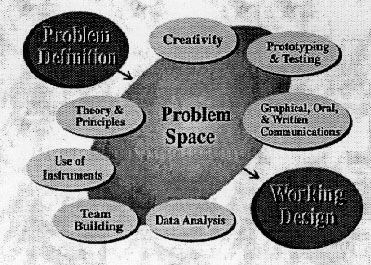
FIRST-YEAR DESIGN CURRICULUM AT 19 CAMPUSES
THE PENN STATE FIRST-YEAR ENGINEERING DESIGN
Several colleges in the NSF sponsored Engineering Education Coalition have efforts underway to redesign the first-year engineering course as a design course1,2. This is also one of the missions of the ECSEL (Engineering Coalition of Schools for Excellence in Education and Leadership), constituting of University of Maryland, University of Washington, Penn State, MIT, Morgan State, City College of New York, and Howard University.
The first-year engineering course at Penn State has developed the following goals with the mission of introducing engineering early in the undergraduate curriculum: (1) Introduce an engineering approach for problem-solving through team projects; (2) Demonstrate the importance of graphical, oral, and written communication skills; (3) Incorporate the skill oriented tasks, such as analysis and interpretation of experimental data, into team oriented design projects. Essential skills taught in the first-year engineering course are:
This paper discusses the challenges and opportunities that are involved in instituting a design-driven first-year curriculum at a large university with a large number of feeder campuses. The paper will discuss issues related to design curriculum development, type and ingredients of a team design project, laboratory preparations, and the benefits of implementing the design activities.
The first-year design course is currently implemented at 19 campuses in the Penn State system. The model involves developing a competency based course structure, identifying coordination team, identifying a coordination mechanisms using appropriate technologies, faculty development, and incentives to sustain long-term coordination. At the core of the coordination and collaboration efforts are student driven activities, and it is these activities that will sustain this effort in the long-term. A large part of the student activities involves archival of student design work as electronic portfolios. These portfolios are shared with the feeder campuses which is a significant part of student-student, faculty-student, and industry-student collaboration. Although our efforts are ongoing, significant gains have been achieved in the past four years that are worth sharing with the engineering education community.
INTRODUCTION
In order to implement a design curriculum at the first-year level in engineering, several factors must be considered: the student level of prerequisite knowledge of engineering concepts, the breadth of engineering topics to be covered, and the format for presentation of the design. Lack of certain prerequisite knowledge of engineering concepts can be the biggest stumbling block. However, if the design includes an application of physics principles or relies on the mathematics that is most commonly encountered in the first-year, then the design serves the dual purpose of integrating the math and science into the engineering curriculum. Engineering design rarely focuses on one discipline, but rather is interdisciplinary. A simple design activity such as designing a bathroom weighing scale may involve mechanical and electrical engineering principles, and may also involves issues related to marketability, packing, aesthetics, etc. A key factor when introducing design at the first-year level is to include these realistic situations and illustrate the inter-disciplinary nature of design from the beginning. Additionally, the format of design must be considered from both instructor presentation and student deliverables. Oral, graphical and written communication are important in conveying design solutions.

Figure 1: "Introduction to Engineering Design" components and their inter-dependence. down
In late 1980's, our design projects were limited to paper designs that could be handled graphically1. Emphasis in those early projects was placed on geometric constraints and the assignment was limited to a set of working drawings. In the early 1990's we placed equal emphasis on graphics, CAD, simulation and experiments. A hands-on design project was the culmination of instruction in all those tools and skills. While the individual components in the course structure were becoming better defined, the engineering design component was still weakly linked to the other components3. Since 1992, an effort was made to combine lab experiments with engineering applications4 and provide instruction in design, teamwork and creativity. The design activities presented herein strengthen the curriculum that was developed earlier2. While topics have been retained, the emphasis is now placed on design. The other course components are treated as skills necessary to achieve a successful design, as illustrated in Figure 1. This approach provides a strong context for many of the skills students learn in class and expects students to practice these skills.
CLASS ORGANIZATION & COURSE STRUCTURE
At Penn State, the total enrollment of incoming first-year engineering students (in 19 campuses) exceeds 1800 per year. All engineering students are required to take the introductory course, "Introduction to Engineering Design". This is a 3 credit course with 6 contact hours per week. The class size is maintained at 32 students per section, and 13 to 15 sections are offered per semester at the University Park campus.
Each section has an undergraduate teaching assistant working with the faculty during most of the design activities. Teaching assistants are junior or senior students who have taken the course and who can provide mentor-ship to the first-year students. The teaching assistants provide guidance with the design projects. An added benefit to having upper-level undergraduate teaching assistants is that the first-year students can identify with the upper-class member. The teaching assistants are also available during evening hours providing general help related to course material.
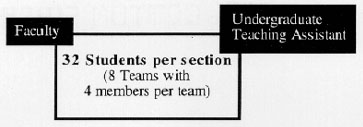
The students are expected to work in teams and each team consists of four members. Their course grade reflects their effectiveness to function within a team. Students participate in exercises that help them understand the mechanics of effective teamwork. They learn how to organize and manage a team, establish roles, set goals, and measure performances.
Most design projects involve class competition or exhibition. The best team from each section participate in an inter-sectional competition to determine an overall winner. Although the course grade does not directly reflect the performance in the design exhibition, the exhibitions are used to raise the enthusiasm to strive for the best possible design solution. This atmosphere nurtures an environment for cooperation between members of the team and competition among teams. This environment is also healthy for creativity and forces students to stretch their skills to the limit.
Table 1: An example schedule for the design curriculum
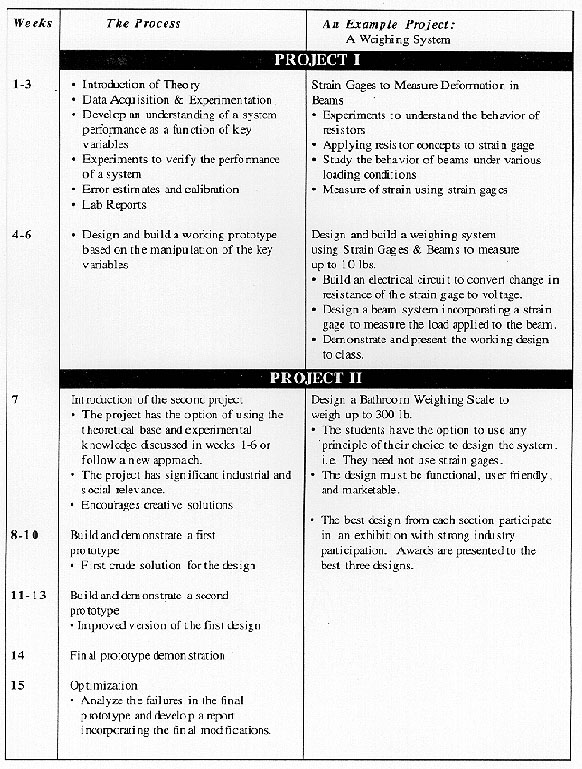
DEVELOPMENT OF A DESIGN CURRICULUM
Developing a design curriculum for first-year engineering students is a delegate process when one considers that such curriculum must:
(1) give students a sense of what engineering is and what the engineering design is,
(2) accommodate different levels of background in science and math,
(3) emphasize relevance of science to engineering and engineering design,
(4) be easy to understand and apply, yet be interesting and challenging,
Also, the fact that the first-year engineering course is likely to have no pre-requisites mandates that the design curriculum must be self contained. The theme of each design project is not as important as the skills learned by doing the projects. However, having a motivating theme seems to increase students' interest and their degree of involvement in the projects. Therefore, careful planning and piloting are essential before adopting a design curriculum for the entire first-year class.
The first-year design curriculum at Penn State5 includes problems which focus on an engineering principle, have multiple solutions, encourage the student teams to explore several possibilities, build prototypes of the best ideas, and finally demonstrate and document a working design (Figure 1). The curriculum focuses on teaching students the basic skills needed in engineering design through hands-on experience that eases the transition from theory to applications and working prototypes. Students complete two design projects over the semester, with each project spanning six 2-hour sessions in a laboratory setting. An example design project is outlined below to illustrate the pedagogy and the overall design expectations.
An Example Project: Design & Build a Weighing System 6
The project is divided into two major parts as Project I & II (Table 1). The particular emphasis of the first project is to build a working prototype of a weighing system using strain gages and a beam. The project is presented and discussed where the main concepts and the necessary instrumentation are identified. The focus of the curriculum is to gradually allow the students to master the concept and apply it in their design of the weighing system. Lab experimentation is critical. Experimental verification of theoretical results is also critical. The students maintain lab notebooks containing the details of their work, which includes lecture notes, data gathered, data analysis, charts, etc. The students are closely guided in this project, so as to ensure that each team in the class will achieve a certain degree of success.
In the second design project, which is often related to the first project, the students are required to design for a wider set of specifications, and a larger set of variables. For example, design a bathroom weighing scale to weight up to 300 lbs. with a resolution of 5%. Each team is expected to consider several possible solutions. A prototype of the best solution is then built, demonstrated in class, and documented in the form of a presentation and written report (Figure 3). Most projects also have an industrial sponsorship to provide a strong context to the design activity.
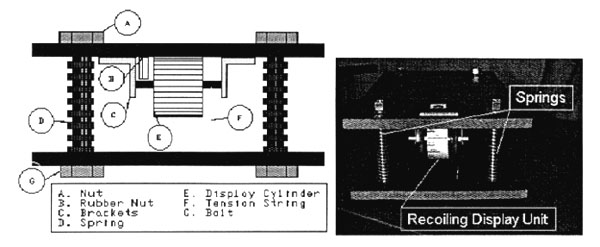
Figure 3: A sample student design showing the schematics and the prototype of a weighing scale. up
DEVELOPING TEAM DESIGN PROJECTS
Our initial efforts at design projects tended to include an element of fun. The relevance to an engineering product was limited or nonexistent in most cases. The lack of industrial relevance or connection to engineering principles that would be of value in engineering design was viewed as a shortcoming. The opportunity to relate engineering principles to products is worth pursuing, not only because it reinforces the material that students are learning in their math and physics courses, but because it illustrates the importance of being literate in disciplines.
Ideally, the design project is introduced by engineers from an industrial sponsor, but if that is not possible, the instructor should relate the design project to an industry. As an example, several semesters ago, the first-year design project was presented by engineers from a paper products plant. The design problem was to develop an automated system that would sort various wood chips based on size and weight so that the proper combination of wood chips could be processed to make specific weights and qualities of paper. The students were not given wood chips, but instead twenty-five balls that contained a mixture of three types of balls- Type 1: weight, W, diameter, D; Type 2: weight, W, diameter, d; and Type 3: weight, w, diameter, D. The students' reports focused on automated processing methods and clearly showed that they treated the balls as wood chips and were able to present their ideas in the context intended.
Using just-in-time approach to presenting the soft skills, the appropriate engineering principles, analysis methods or relevant calculations are handled as the need arises through the project. Recently, students were asked to maximize the efficiency of transporting bars of soap vertically. Efficiency was measured as the ratio of the potential energy at the end of the cycle to the work put into the system. A well-timed lecture will reinforce the critical design components and illustrate the analysis needed to compute efficiency. Further refinement and analysis can be handled by repeating the calculation.
A well thought and planned project must include several essential as well as
complementary ingredients. For the essential ingredients, the project must:
- be do-able with some degree of success and within the time limit
- involve several parallel and inter-related tasks
- have multiple solutions whose concepts can be easily understood
- involve reasonable level of analysis, not just trial and error
- have a measurable and rewarding results
- have an element of challenge
and for the complementary ingredients, it is desirable that a project has:
- a motivating theme
- industrial relevance
- an industrial sponsor
- a competition element
A SCHEME FOR CONTINUOUS CURRICULUM IMPROVEMENTS
The course has been designed and tested in pilot sections before full implementation. Lessons learned from pilot testing are used to improve the curriculum for further testing, until the faculty and the undergraduate teaching assistants are fully prepared for full implementation. With time there is a continuous need for curriculum upgrades. For large scale implementation of curriculum upgrades there must be a scheme to pilot test, develop course material, and train personal to make the necessary changes.
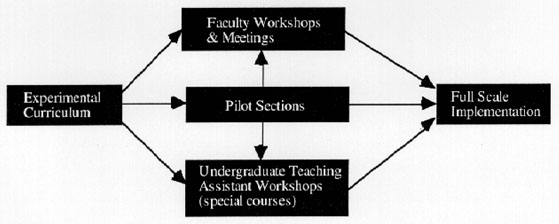
Figure 4: Evaluation and assessment are conducted both in pilot sections and after full-scale implementation
For example, the Solid Modeling component was implemented using a similar scheme in Fall 1991. A workbook 'Computer-Aided Design Using Solid Modeling' was used as a student guide7. Solid modeling was pilot tested in two sections in Fall 1992. During this time, faculty workshops were offered to retool faculty with the new concepts, since most faculty were not exposed to these topics during their career. In Spring 1993, a new technical elective course, 'Introduction to Solid Modeling', was offered to train teaching assistants on the topic. At this time, four sections of the course used the solid modeling. The workbook developed for the curriculum was continually revised and updated in preparation for full scale implementation. In Fall 1993, all 15 sections at University Park campus offered the new component. The workbook also has received attention from other colleges in the country, where currently, it is used by approximately seventy colleges and universities.
Some of the curriculum upgrades are small. However, the changes are still pilot tested in a few sections before full scale implementation.
A COURSE COORDIANTION AMONG 19 CAMPUSES
The 1800 first-year engineering students can take the first-year engineering course at any of the 19 campuses in the Penn State system. This presents a serious challenge in terms of ensuring consistency in course expectations, competencies, content, and types of learning experiences offered at the various locations.
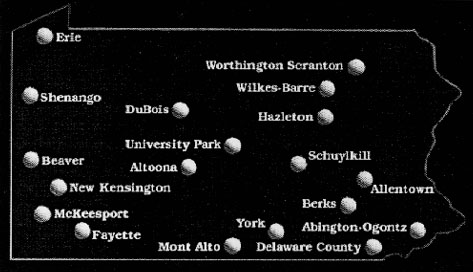
Figure 5: The State of Pennsylvania showing the locations of the 19 campuses
The key to implementation of a course that successfully meets the course expectations at multiple campus locations is that the faculty teaching the course must have "ownership" of the course. Ownership can be achieved by allowing faculty to tailor the course according to her or his interest, expertise, and resources available8. When more than one faculty member teaches the course in geographically dispersed campuses, we would need a shared ownership or collaboration. This concept of ownership of the course, or delegation of responsibility, is specially important when teaching design courses, where the success of the course is heavily dependent on the instructor's enthusiasm for the course. This is a dramatic shift from the traditional model, where faculty were told exactly what topics and chapters to cover by their predecessors based on a specified course outline. Also, in the traditional model the course outlines were uniform and therefore, it was assumed that the course is uniform among the campuses. Since the course uniformity was highly determined by the course outline, collaboration on the course content was not a necessity.
The new coordination mechanism among the Penn State feeder campuses follows a competency based model. This model allows faculty to define their own course outline satisfying a specific set of competencies that is uniform across the system. The competencies were developed, collectively by faculty, students, and industry partners around the design curriculum expectations described earlier in Section 3. The competency based model for course coordination encourages unique course outline at each campus, which provides opportunity for proactive curriculum improvement. This type of a course coordination structure demands collaboration through sharing of course materials.
With the competency based coordination model, there is expected to be a wide range of approaches that can satisfy the same set of competencies. This is healthy for a proactive curriculum as long as there is strong coordination and collaboration mechanism.
The coordination mechanism has the following features:
SUPPORT MECHANISMS FOR COLLABORATION & COORDINATION
We clearly face new challenges in maintaining coordination of the curriculum and sustaining continuous curriculum improvements. These challenges are obviously burdened by the geographical dispersion of the campuses. To address some of these challenges, a collaborative project was developed to implement systemic changes that will sustain the coordination among campuses and industry using information technologies. The strategies for implementing the changes are as follows:
Development of a resource database using the World Wide Web to share curriculum-related information 5.
Faculty development workshops are crucial to the collaboration effort.
In order to institute systemic changes in the practice of coordination, the faculty must be proactive in the use of technology. Opportunities and resources were provided for the faculty to develop their skills in the use of the technology. In addition, the workshops provide resources and mechanisms to remain current with changing technology. Regional faculty workshops are held to give hands-on experience in developing the on-line course material. The goal of the workshops is not to ensure that the faculty become experts in the use of the technology, but be able to apply the technology to sustain the database for continued coordination.
Resources to acquire computer hardware to implement the technology.
Access to computer technology is always a serious limitation at small campuses. Therefore, funds are made available to provide matching funds for hardware and software to the faculty teaching the first-year engineering course. The objective was to help faculty acquire appropriate hardware and software that can be used to develop and access innovative course materials. The broader goal was to develop a multimedia resource database for the course including project ideas contributed and utilized by faculty.
Mechanisms for faculty and industrial collaboration in student projects using video conferencing technologies.
Over the years we have had some modest, but valuable industrial participation in the curriculum. However, bringing in active industry involvement is a challenge. This is rather difficult for campuses that are not located close to industrial sites. In addition, most forms of industrial participation involve significant commitment by industry, which may involve engineers traveling and one or two days away from work to meet with students for a few hours. This is certainly not feasible in the long run at a time when the industries are operating on lean budgets. Input from industry managers and practicing engineers was critical in the development of program competencies and will continue to be important in course delivery.
Affordable tele-conferencing technologies to enable frequent discussions with industry sponsors are being studied. For example, practicing engineers can participate in class discussions involving design projects on a weekly or bi-weekly schedule without leaving their offices. Video conferencing has been pilot tested using the CU-SeeMe10 software. The students react very positively during these sessions. This exposure to engineering role models is very valuable for retention of students who have no such role models among their friends or families. It is clear that this type of interaction along with the web-based projects database will be a very strong feature of the design courses. Video conferencing technologies are evolving rapidly, and several affordable alternatives are available today, such as the ProShare system by Intel11 or the PictureTel12 system.
ASSESSMENT STRATEGIES
a. Effectiveness of Instructional Material
Innovative learning environments necessitate different assessment measures and evaluation procedures. Consequently, the tools for evaluation that are most appropriate in this context are those which are more comparative and qualitative in nature. Additionally, the ability to assess enhancements in faculty's teaching practices and students' learning processes in this project is greatly limited by how recently these practices have actually been implemented. The majority of assessment activities are in the process of being developed and implemented at this time. One area of interest is the long-term student progress. Assessment instruments are currently being developed to study the following issues:
The instruments are made available on-line via WWW to allow for wide and prompt distribution of the survey, and will allow for automated processing of the data.
From the overall assessment of the database an external reviewer, such as a ABET reviewer, will have the opportunity to assess the effectiveness of the course as implemented at all the 19 campuses. Furthermore, this level of collaboration among multiple campuses will not only nurture an environment for continuous improvement, but force faculty and students to be accountable for the quality of the course, which is the basic requirement for ABET 2000.
b. Student Feedback
To assess the new design curriculum, students were surveyed during the transition semester where half of our first-year students were taught the traditional graphics curriculum and the other half were in the new design-driven curriculum. Needless to say that all our sections are now using the new design-driven curriculum, the results of this survey clearly demonstrated that the new curriculum is in the right direction.
The majority of the students (79%) liked working in teams, and most (64%) thought that they learned a lot from working in teams, even though most of the students did not think that working in teams helped their grade. Also, students liked and felt that they learned from the team design projects and competition. When compared with the old curriculum, students thought that they learned more, enjoyed more, and were motivated more by the new curriculum, even through they had spend more hours on the new course. In fact, students considered the design projects and the competition to be the most motivational component of the course. However, the most encouraging feedback is that almost two-third of the students thought that the first-year course increased their interest in engineering. It is also evident from our surveys that continuous improvement of the curriculum is essential for maintaining the strong image of the course.
IMPACT OF THE NEW CURRICULUM
The impact of the first-year engineering course development is evident in several areas. What began as a course improvement has developed into a highly successful program with benefits that extend into upper division courses, high school summer programs and interactions with other institutions that have, or are developing, first-year engineering curricula.
Advanced Courses: Natural extensions to the program have included the development of more advanced courses at second and third year design, product dissection, modeling, manufacturing, etc. These courses were created out of a need to advance the students' engineering design experience which seems to be motivating the factor to enhance student learning and their interest in engineering. Recently, the College has undertaken a major reform of the core undergraduate curriculum, which proposes to integrate design throughout the four years of the engineering program.
New Facility: A new technology classroom was specifically designed to meet the needs of the undergraduate curriculum. The classroom is an integration of a traditional computer lab, a lecturing classroom, and multimedia technology. The new classroom is intended to encourage faculty to incorporate innovative instructional technologies in the undergraduate engineering curriculum. First-year through senior-level courses use the classroom. The classroom was funded (approx. $500,00) by the College and the NSF supported ECSEL project.

Figure 6: The ECSEL Undergraduate Computer Classroom13
Summer Programs: Further evidence of the positive impact of the first-year course can be seen in a number of summer programs and workshops that have adopted the structure and methods of implementation developed for the first-year curriculum. High school students (10 th through 12 th grades) are introduced to engineering through a variety of activities. In an effort to have students participate in a hands-on engineering design problem, the workshop includes a focused project that consists of the design and analysis component module from the first-year curriculum. These are held in concentrated sessions that culminate in the building and demonstration of their design.
Outreach: Another important constituency in our outreach efforts is the group that influences a student's career choice: high school math and science teachers and guidance counselors. Since 1992, the first-year design course has been a component of a summer workshop sponsored by the College. The program is directed toward high school educators and counselors to allow them to explore and understand engineering career opportunities for their students.
Faculty Rewards: Due to the involvement in the development of the first-year design program the faculty have received numerous awards, namely, 1994 and 1996 Dow Outstanding Faculty Awards, 1997 Outstanding Practice in Instructional Development, 1993 through 1996 Provost's Award for Collaborative Instruction & Curricular Innovation. Also, individual departments at Penn State now recognize the importance of having a strong first-year engineering curriculum. The course has earned a reputation as an example instructional model in the university and at other institutions.
CONCLUSIONS
The rewards of involving first year engineering students in design projects are numerous: early exposure to engineering, learning team work, development of oral, graphical and written communication skills, and learning about engineering instruments and software, are to name just a few of the benefits. It is important to build the design work with a strong foundation math and science. Industrial relevance to the design projects will provide the necessary relevance and context for the projects.
Use of technology is a valuable tool. However, the technology must be carefully introduced so that goals of the curriculum are enhanced. The archival to student work as design reports or portfolios is a powerful resource. The students can use it as a reference of their work in their resumes and future courses. Also, faculty can use the database to share project ideas and to measure the level of design activity.
For institutions that depend on large number of transfer students at the sophomore level, the coordination of the curriculum with the feeder campuses is a challenging task. Coordination of a design course will require that the faculty at the campuses have flexibility in implementing the curriculum. The competency based model discussed in the paper is a strong model for coordination with the feeder campuses. However, the competency based model must be supported by a strong collaboration team to ensure that the diversity of the course is a strength, and to avoid fragmentation of the curriculum.
REFERENCES
1. Koen, V. (1994). Toward a Strategy for Teaching Engineering Design. Journal of Engineering Education, v.83, n.3, pp. 193-201.
2. ECSEL Integration of Design Publications.
http://echo.umd.edu/general/pubspres.html#designfresh
3. Sathianathan D., R. Engel, and R. Foster. 1993. A Freshman Engineering Design Course. Proceedings of the ASEE Annual Meeting 1993. 883-888.
4. Kallas M. N. and Sathianathan D. 1994. A Shell Approach to First year Design Curriculum. American Society for Engineering Education: Annual conference.
5. Engineering Design & Graphics 100 (1996). The Pennsylvania State University. http://www.ecsel.psu.edu/setce/EDG100/.
6. Kallas M.N. and Sathianathan D. 1995. Designing a Weighing System Using Strain Gages and Beams. Hayden-McNeil Publishing, Inc. ISBN 1-57182-089-2.
7. Sathianathan, D. and Q. Sayeed. 1995. Computer Aided Design Using Solid Modeling. Schroff Development Corporation, Mission, Kansas.
8. King, J. A., and Evans, K. M. (1991). Can We Achieve Outcome-Based Education?. Educational Leadership, October 1991, pp. 73-75.
9. Engineering Design & Graphics 100 - Projects Database (1996). The Pennsylvania State University. http://www.ecsel.psu.edu/setce/EDG100/Projects.html.
10. Live Over the Internet - CU-SeeMe. White Pine Corporation. http://goliath.wpine.com/cu-seeme.html.
11. Intel ProShare Conferencing. http://www.intel.com/comm-net/proshare/
12. PictureTel Corporation
http://www.picturetel.com/
13. The ECSEL Undergraduate Computer Calssroom. http://www.ecsel.psu.edu/
Acknowledgments
The authors are grateful to AT&T Foundation, Penn State Center for Academic Computing, and National Science Foundation sponsored Engineering Education Coalition ECSEL for the continued support of projects in the first-year engineering education. The authors are also very grateful to the project consultant, Professor Robert Foster.